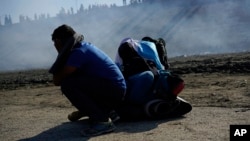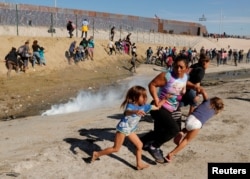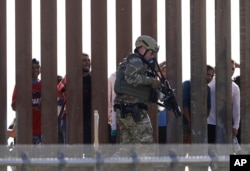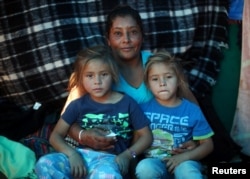Concertina wire had been laid, extra border patrol officers had been deployed to the U.S. Mexico border, and ports of entry, “hardened.” Yet, none of it stopped the border clash on Sunday when suffocating tear gas was fired by U.S. Customs and Border Patrol officials against Central American migrants whose peaceful protest had spiraled out of control.
In a briefing with reporters Tuesday, U.S. Department of Homeland Security (DHS) officials said what happened Sunday was a “routine border protection mission against a violent mob of 1,000 people.” (The Mexican government puts the number at 500).
“This group was predominately male and many were throwing projectiles including rocks and concrete at border patrol agents,” Tyler Houlton, DHS Press Secretary, told members of the media.
But the choking tear gas, known as CS gas, is considered to be a chemical weapon that was outlawed on the battlefield by the United States and other nations in a 1993 agreement. The Chemical Weapons Convention banned the use of chemical weapons in war, and also the production and stockpiling of weapons.
“Those are chemicals that we normally don’t even use in combat anymore. So, this is completely unheard of. And we don't throw these at people that are trying to seek asylum,” said Mana Kharrazi, executive director of Iranian Alliances across Borders.
However, the use of tear gas is sometimes legal within the confines of the U.S. and may be used by police and federal law enforcement.
American Civil Liberties Union Senior Staff Attorney Carl Takel puts an emphasis on 'sometimes.'
“The constitutional standard for use of tear gas by domestic law enforcement like other uses of force is the Graham v. Connor ‘objective reasonableness’ standard," he told VOA. "They cannot use tear gas arbitrarily and without warning...and I have difficulty imagining any circumstance in which it would be permissible to target tear gas canisters at unarmed young children.”
Only an irritant?
Reuters photographers captured children and their mothers as they fled from the tear gas. In one photo that has gone viral, Maria Meza races to help her two young barefoot children escape the canisters fired by U.S. authorities.
“I was sad, scared, and waiting to cry,” she told Reuters. “That’s when I grabbed my daughters and started running. At that moment I thought I was going to die with them because of the gas. It wasn’t right. They know we are human beings, the same as them. It wasn’t right they did that to the children.”
According to reports, Meza fell into the mud before another male migrant pulled her up.
San Diego Border Patrol Chief Agent Rodney Scott said on Tuesday U.S. officials do not target women and children.
“If women and children choose to insert themselves into a violent crowd that is attacking police officers with rocks and bottles, there are going to be unintended consequences. We’re doing everything we can to message that at the migrant shelters,” Scott said.
Scott said border patrol agents are using the “least intrusive tools” they have.
“The United States Border Patrol agents will not stand there and get assaulted with rocks and bottles and not respond," he added. "... Again, I want to state that the pepper gas is an irritant, there is no permanent harm, but the easiest way to avoid it is comply with the law, go to the port of entry and then get in line with everybody else."
Waiting for asylum
On Monday, the Mexican government released a statement saying 98 people were placed on removal proceedings due to “violent behavior” towards the Mexican federal police at the U.S. Mexico border.
On the U.S. side, border patrol agents arrested 42 people who had illegally crossed the border. Of the 42, seven were women and a few were children.
Since the arrival of the migrant caravan two weeks about in Tijuana, Mexico, local authorities in both countries have ramped up security.
A spokesman for the United Nations International Children’s Emergency Fund, UNICEF, told VOA that as of November 21, 4,731 migrants had arrived in Tijuana. Among them are 862 children. In addition, UNICEF said another 4,000 migrants were on the way to Tijuana.
Criminals in the crowd?
DHS officials claim that 500 to 600 identified criminals are among the migrants trying to cross into the United States. But on the same call to reporters, officials refused to explain what methods were used to confirm they have these migrants’ criminal records. News reports have said paid informants were embedded with the migrants.
“Through intel sources we’ve identified at least 600 criminals in and around the caravan," Houlton said. "... We can’t get into how those methods are conducted. That’s all I can tell you. The people have criminal records that we’ve identified.”
Asylum waiting list
Those hoping to apply for asylum in the United States are putting their names on a waiting list that reportedly already had 3,000 signatures before the arrival of the caravan in Tijuana.
U.S. officials have been processing about 100 claims a day, and the wait time for the recent arrivals is expected to be months.
“They're coming from countries that are deeply affected by a lot of our policies and affected by conflict and years of struggle. So, they have very valid cases for seeking asylum,” Kharrazi said.
Under U.S. law, anyone arriving at a port of entry or crossing in between ports of entry is eligible to apply for asylum if they have a fear of returning to their home country. Trump issued a proclamation November 9 that barred anyone from claiming asylum who entered the country illegally. But a federal judge blocked the measure until it can be tried in court December 19.
Without offering more details, DHS officials said the vast majority of migrants are coming for “economic reasons and not asylum.”
“Wanting to work in the U.S. is not asylum, wanting to be united with family in the U.S. is not asylum,” Houlton said.














